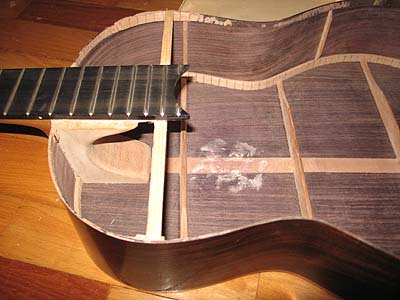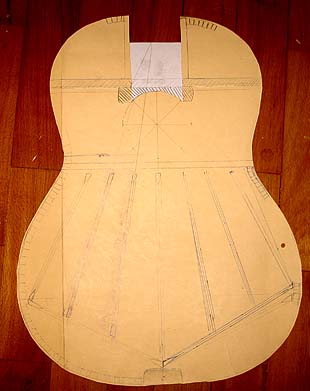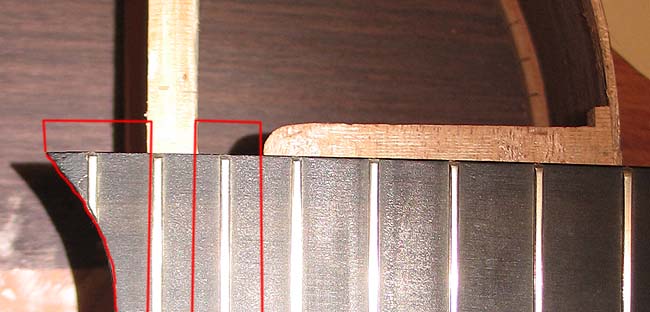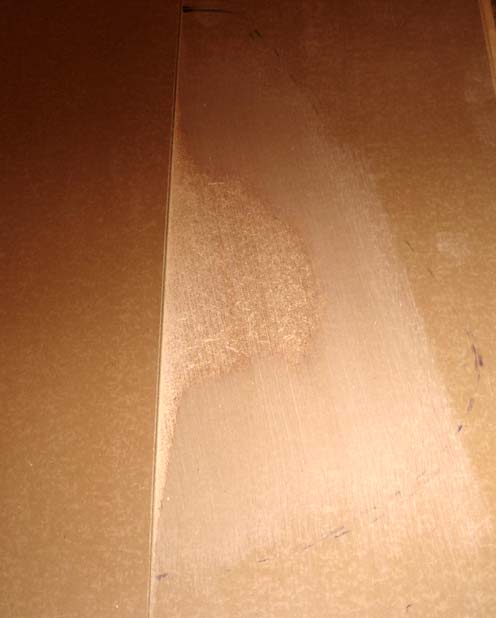And the pics.


| Official Luthiers Forum! http://w-ww.luthiersforum.com/forum/ |
|
| My first guitar project http://w-ww.luthiersforum.com/forum/viewtopic.php?f=10102&t=11356 |
Page 1 of 1 |
| Author: | Alexandru Marian [ Thu Mar 22, 2007 11:53 pm ] |
| Post subject: | |
My first post here :) Congratulations to all luthiers for the wonderful instruments you create. I am hoping to get some hints that might turn my first project from a total disaster to a decent guitar. I always enjoyed building various things, and I always dreamed about constructing a guitar. Recently i was moving things around the house and found an old cheap guitar with plywood b&s which had several cracks in the top and was used as living room decoration. On a whim i decided the get a piece of spruce and replace the top for the fun of it. Later I decided that the poor construction and the plywood do not really deserve the nice wood I was getting. I ended up removing the top from one of my good guitars. Good as in easily played, IRW b&s. It was a cheap factory guitar with thin sound, lacking the Spanish warmth and tone. I ordered a serviced Engelmann spruce top from one of the sponsors here, plus the needed extras: kerfing, binding, glue, brace wood, bridge. I got lucky with the heel of this guitar. It is wider than the fingerboard as seen in the pic below. Removing the fingerboard would have required a lot of work and risk for a complete beginner. My current plan is to cut a fingerboard shaped part from the top and simply fit it in. If the join line turns ugly, I could cover up with an inlay of the nice bloodwood binding i am using. My main concerns are with the important steps of the process. The serviced top comes at a flat 2.8mm thickness. Of course i have no idea on how to fine tune it to get the best sound out of it. Here I hope for luck and divine intervention :) I am thinking i will reduce the center thickness to about 2.6mm, and graduate to about 2.2 at the edges. I will probably make taller fan struts and sand through the soundhole if it sounds too tight. I can also sand the entire top from the exterior. I am concerned about the slight top arching I have noticed on the good guitars inspected in the past, especially the one under the bridge tie-block. I do not know if i need to scallop the bridge, or if this arching is created by string tension alone. Then there is the middle harmonic bar: combined with the graduated top, will result in slight arching, but I do not if there should be a bit of scalloping in the bar as well. The attached pics show my first attempt at a top and bracing template, and the guitar (I am currently removing the old kerfing and cleaning up all glue residue on the RW). I am not sure if i should keep the upper bar in place. i could say it sits well there :) but its made out of generic spruce: not quartersawn, very coarse grain and lot of runout. I imagine all professionals will have a good laugh at what i am doing, but I guess most people start with something silly and learn on the way. The wood is on route and i should pick it up Monday. |
|
| Author: | Alexandru Marian [ Thu Mar 22, 2007 11:58 pm ] |
| Post subject: | |
And the pics.  
|
|
| Author: | crazymanmichael [ Fri Mar 23, 2007 2:08 am ] |
| Post subject: | |
what you have started is a difficult project; it would probably have been easier to start from scratch. but, first you will have to remove the fretboard, and remove the vestige of the old top under it. it will not be strucurally sound to proceed as you suggest. removing the fretboard is a simple step compared to what you are already attempting. read up on it in the archives and if you have any questions, ask. before you do this pull the 1st and 11th frets, and drill a fine hole in the slot to take two locating pins, fine brads will do, so that you can get the fb glued back in the correct position. as to your preconceived notions as to top thickness: the best thickness will depend on the stiffness of your wood, and the effects of your bracing. you may need to read up a bit on that as well, and come back with the questions the reading will provoke. |
|
| Author: | Alexandru Marian [ Fri Mar 23, 2007 3:12 am ] |
| Post subject: | |
Dear Michael, Thank you for taking the time to reply. Any word from a professional is much appreciated. The FB removal prospect is scary. I will read some more on it and think again. When i opened up the guitar and found the wide heel I was quite happy. As per pic, there is a wider than kerfing gluing area and I was going to add two crossgrained spruce plates as per the red drawing. I certainly don't want to have preconceived notions about thicknesses. I know every top is different, even if cut from the same billet. My plan was to make it a bit overbuilt, thicker, and taller struts that average, then, if i feel it is needed, to sand the top from the exterior and shave the braces through the soundhole. So far I have found some very interesting figures in the topic about the Romanillos workshop, and i might switch to his pattern instead of the torres/Hauser type I had in mind before. I imagine that the stiffness can be somehow measured by using a certain weight and measuring the travel and how much it bends on the grain and across the grain. An experienced luthier probably knows these things by simply flexing the wood in his hands. I imagine some might take measurements for future consistency. So far i could not find anything about this, but I'll search some more in the archives, only found this forum today. Alex 
|
|
| Author: | csullivan [ Fri Mar 23, 2007 4:47 am ] |
| Post subject: | |
Alex, this shouldn't be too bad a project. Rather than removing the entire fretboard, just remove the fret at the body juncture (probably the 12th or 14th fret) and carefully cut through the slot with a small back saw. You can now remove the remaining piece of top with the fretboard extension. Then you can easily remove all the old top wood from the back of the fretboard extension and reinstall it to the new top, once the new top is glued in place. I'd also remove the old top brace. That way, all your braces will be affixed to the new top before you glue it to the sides. This method also allows you to tuck the ends of the binding neatly under the fretboard. I have successfully replaced a number of tops this way. The only other thing I did before I removed the old top was to make a quick, open form traced from the guitar before I removed the top. When I was ready to glue on the new top I would slide the form down over the sides to hold them in shape. Good luck. Craig S. |
|
| Author: | Alexandru Marian [ Fri Mar 23, 2007 6:26 am ] |
| Post subject: | |
Thank you Craig ! I will put this option on the list as well. In any case, deciding about how I join at the fretboard will be the last thing i do (except bridge gluing). Will take a while until I graduate the top and cut / install braces. Alex |
|
| Author: | Martin Turner [ Fri Mar 23, 2007 10:52 am ] |
| Post subject: | |
Id take the fretboard right off. I'd also consider a patch or a bit of bracing around the soundhole. The same goes for a patch under the bridge. Removing a fretboard isn't that scary as long as you work to a plan and dont rush the job. If youre going to dome the top then you'll have to work out a way of maintaining the correct arch while you fit braces. I work on a workboard which has been dished out in the lower bout area to about a 15" radius. Good luck |
|
| Author: | Martin Turner [ Fri Mar 23, 2007 10:55 am ] |
| Post subject: | |
Alex, check here for some pics of a Hauser classical Im working on. You can see the bridge patch and soundhole bracing in the photos. Cheers |
|
| Author: | Alexandru Marian [ Fri Mar 23, 2007 11:14 am ] |
| Post subject: | |
Thanks Martin! it seems the link didn't work. I will certainly patch around the soundhole, just that I left it out of the drawing. Not sure if I will bother to do it under the bridge. So far i read it depends on how stiff is the top across the grain (i guess i'll have to use my instinct and decide myself if it feels strong enough ) and that most people do not use it for spruce, only for cedar. My top is Engelmann, AAA from LMI. They say they pick these for stiffness too, not just aesthetics. What is the actual effect of doming? More stiffness, more volume? Is it changing the tone ? |
|
| Author: | Martin Turner [ Fri Mar 23, 2007 12:18 pm ] |
| Post subject: | |
Sorry, fotgpt to paste in the link. Here it is: http://www.luthiersforum.com/forum/forum_posts.asp?TID=10840 &PN=1##156723 |
|
| Author: | Martin Turner [ Fri Mar 23, 2007 12:18 pm ] |
| Post subject: | |
Sorry, forgot to paste in the link. Here it is: http://www.luthiersforum.com/forum/forum_posts.asp?TID=10840 &PN=1##156723 |
|
| Author: | Martin Turner [ Fri Mar 23, 2007 12:24 pm ] |
| Post subject: | |
[QUOTE=AlexM] Thanks Martin! it seems the link didn't work.I will certainly patch around the soundhole, just that I left it out of the drawing. Not sure if I will bother to do it under the bridge. So far i read it depends on how stiff is the top across the grain (i guess i'll have to use my instinct and decide myself if it feels strong enough ) and that most people do not use it for spruce, only for cedar. My top is Engelmann, AAA from LMI. They say they pick these for stiffness too, not just aesthetics. What is the actual effect of doming? More stiffness, more volume? Is it changing the tone ? [/QUOTE] Alex, I'd put in a bridge patch. As well as strengthening the top around the bridge area IMO it also improves the sound of the instrument. You'll find that alot of makers, especially post Hauser use them under Englemann and other spruce tops. The effect of doming? There have been previous discussions on this one, just do a search to find same. My thoughts on doming: 1. it improves the sound of the instrument and 2. it adds strength to the top. As for stiffness...Ive been told by more than one professional luthier to "build light and stiff". |
|
| Author: | Alexandru Marian [ Fri Mar 23, 2007 7:37 pm ] |
| Post subject: | |
Thanks Martin. I've also found an older topic where you show a pic of your radiused solera. I'm off hunting for a some MDF or particle board to make a scalloped workbench. I've measured a bit on my main guitar, an Alhambra, and it seems to be a bit less than 2mm at the edge. You mentioned "about 2mm" on your solera - that's about the same. There is no scalloping in the bridge. I think I will make that to my bridge, profiling same as the workbench. This should remove stress from the bridge-top joint and from the saddle. For example in my alhambra i cut the saddle straight but it only touches the center of the slot- there is a gap under the E strings. It goes away under full tension but anyway... Your fan braces seem to be the wide and not tall type. Pattern is Tores? I assume that from the larger space at the bottom. The famous Segovia Hauser has a narrow endblock and the fan braces covering more bottom space. |
|
| Author: | Martin Turner [ Fri Mar 23, 2007 9:46 pm ] |
| Post subject: | |
Yes my Hauser's end block is a bit more robust than on the original and proximity of the end of the fan braces to the V braces is a bit different. Brace profiles though are fairly close to measurements taken from the original. My guitar isnt intended to be a faithful reproduction of Hauser's Segovia guitar...the intention is to incorporate as many of Hausers ideas as possible. |
|
| Author: | Martin Turner [ Fri Mar 23, 2007 9:48 pm ] |
| Post subject: | |
Fan and other braces are as per measurements contained in Courtnal's book "Making Master Guitars". |
|
| Author: | Alexandru Marian [ Sun Mar 25, 2007 10:02 pm ] |
| Post subject: | |
After scraping various scraps, Ive settled on some laminated parket i had around. The two pieces join nice and tight, and I have a lot much easier access to it. I can also easily measure the deflection. The material is somehwere between MDF and particle board. Sands nicely, not too difficult, but not easily either - just great. I still have not received the top. Been sent Global Express on 19th and left the States on 20th. Today is the 6th working day. I hope the wood doesn't get warped or smth. Buggered Customs...   |
|
| Author: | Alexandru Marian [ Mon Mar 26, 2007 10:07 pm ] |
| Post subject: | |
I picked up the goodies ! I glued up some 15cm of kerfing to see how the LMI white stuff holds. I have used this kind of glue zillion types before (for example when installing parket) but i don't know if there any special things to consider with this special type. I assume you only need to thinly paint one face of the wood, and hope for good contact between the woods and sufficient pressure. The top (joined by LMI, sanded to 0.11 = 2.8mm) seems stiff along the grain. About as stiff as the carpathian spruce in the cheap first guitar I intended to use, and stiffer than the cedar of the second. The bad news is that it shows a bit of warping, say 30 radius. Before noticing this I choose the face that holds the bracing, and this warping is against the dome, in other words, when placed on the solera, i first have to press it to be flat, then press some more to get in the solera dish. It does not seem to mind all this crossgrain flexing. The cedar removed was not too elastic across the grain and was cracking very easily. |
|
| Author: | Alexandru Marian [ Mon Mar 26, 2007 11:26 pm ] |
| Post subject: | |
Ok i found some older threads and warping doesn't seem to be a disaster issue. I think it was actually the particle board sheet packing that did it. I checked the boards and they are anything but flat, with S' in all directions. I'll put the spruce on a flat table with a couple books on it and let it sit a few days. |
|
| Page 1 of 1 | All times are UTC - 5 hours |
| Powered by phpBB® Forum Software © phpBB Group http://www.phpbb.com/ |
|